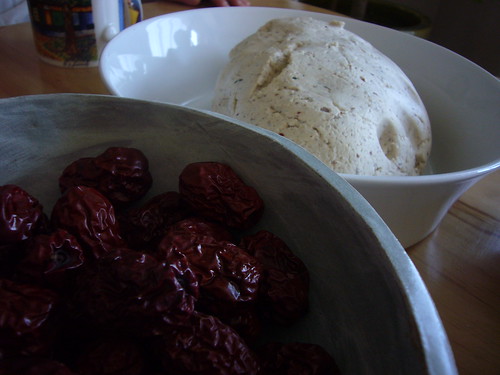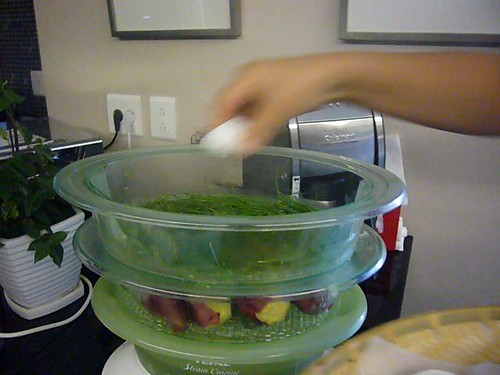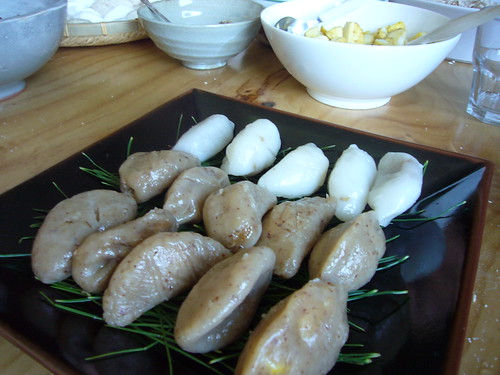Most of the Seoul Patrol has headed out of town to spend quality time with their family (both the dead and living), so the city feels relative empty. Me likes it.
I can't believe I'm celebrating my second Chuseok in the Motherland. Last year, we went to down to Busan to fry fish with Cyndi's relatives. This year, since my mom is still in town, we're spending Chuseok in Seoul. I have to admit, Seoul sans half its population is quite pleasant. As my mom would put it, it's a little less jeongshin eopso. I feel like I have more room to breathe and think.
My cousin Nani invited us over to her house to make songpyun, traditional rice cakes shaped like half-moons. It is a Chuseok tradition for the women of the family to sit around and gab while making songpyun. My family of course is always big on the gabbing and gossip, but we usually buy the songpyun from a store. Fortunately, Nani is quite knowledgeable about Korean traditions and was able to school us on some Motherland culture.
In honor of Chuseok, my family and I offer you a simple tutorial on how to make songypun.
THE "DOUGH"
In order to make the "dough" (not sure of the correct term), take soaked uncooked rice (쌀) to the rice mill professionals (방앗간) and have them process the rice with salt, producing a sticky rice dough.
In order to add color to your dough, you made add one of the following ingredients:
omi tea (오미자차) = pink
jujube (대추) = brownish
mugwort (쑥) or spinach (시금치)= green
By no means, should you use artificial coloring for your songpyun. Nani told me that it is strongly frowned upon in traditional Korean food culture. You can dye your hair, but don't mess with your ddeok.
This is what the "dough" looks like with no additional ingredients.


This is what the "dough" looks like with ground jujube.

THE FILLING
As a product of harvest celebrations, songpyun are filled with beans, chestnuts, or sesame seed pastes. We had three different options:
- chestnuts (밤) mixed with sugar
- sesame seeds (깨) mixed with brown sugar and honey
- sliced jujube (대추) - not pictured


ASSEMBLY
Please view the video for a demonstration of how to assemble the ingredients.
According to my mom, your ability to make "pretty" songpyun foretells the prettiness of your children (she also says this about making mandoo). My mom claims that she was told that her songpyun were very pretty. Following suit, this means that my sister and I are "neomu yebbeo (so hot, hot)" all thanks to my mom's mad skills. I don't care what you haters think. The songpyun never lie.
Based on the sorry songpyun that I made today, let's just pray that my future children have sparkling personalities.
Nani also told me that the songpyun are half-moon shaped, rather than completely round because the shape suggests that you still have something to fulfill (or to accomplish), while a complete circle suggests that your life is complete; meaning there's nothing left to be done. It's all over. At least, that's what I think she said.
It'd definitely be much easier to roll the dough into a little ball, but I appreciate the significance of the half-moon shape. It's a shame, though that my ineptitude for making pretty half moons will mar the beauty of my future offspring. Mama's really sorry, future kids.
STEAMING
Steam your beautiful little half-moons upon a bed of pine needles. The pine's purpose is two-fold. 1) It keeps the songpyun from sticking to the pot. 2) The pine needles infuse themselves in the songpyun, making the ddeok much more tasty and fragrant.

After steaming the songpyun for about 15 minutes or so (no sure about the timing) rinse the ddeok in a bowl of sesame oil, or if your calorie conscious, a mixture of sesame oil and water. The sesame oil will leave your little ddeok babies glistening just like the ones made by the professionals.
TA DA! THE FINAL PRODUCT

Okay, I know that they're not much to look at, but I think we did a pretty good job. We all especially liked the sesame filled songpyun because unlike those stingy professional songpyun makers, our ddeok was bursting with the sweet, honey paste.
Chuseok is the time to pay respect to your ancestors, hang with your family, and give thanks for the bounty of this year's harvest. I hope you take the time to do this, wherever you may be.
Special thanks to my family (Umma, Emi, Emi's BFF, Nani, and Vice President) for letting me blog and post pictures about our songpyun workshop.
즐거운 추석!



3 comments:
I made these at school on Thursday with all my kids. The homeroom teacher showed me how and I just followed her. Every time I would make one, she would say, "Beautiful babies for you! Beautiful girl babies for you!" I was all what the heck? Until my principal told me that if you can make beautiful songpyun, you can make beautiful babies. It was so funny, but I was glad I could make a decent one. Was able to show my future mom-in-law and she was a very proud ajumma!
That video was really cool. I just moved into my new house so I'll be starting to cook all sorts of Korean food soon...hopefully..but songpyun is top on the list of new recipes to try.
I heard of the connection between the looks of children and their mother's ability to make good looking food...its a pretty common theme in Korea...lol....It was probably something they told little girls when they were learning how to cook to make them try harder...lol...kind of cruel if you think about it...lol
Thanks for sharing! I love the how-to, and all the background makes it even better. Happy Chuseok. :)
Lily
Post a Comment